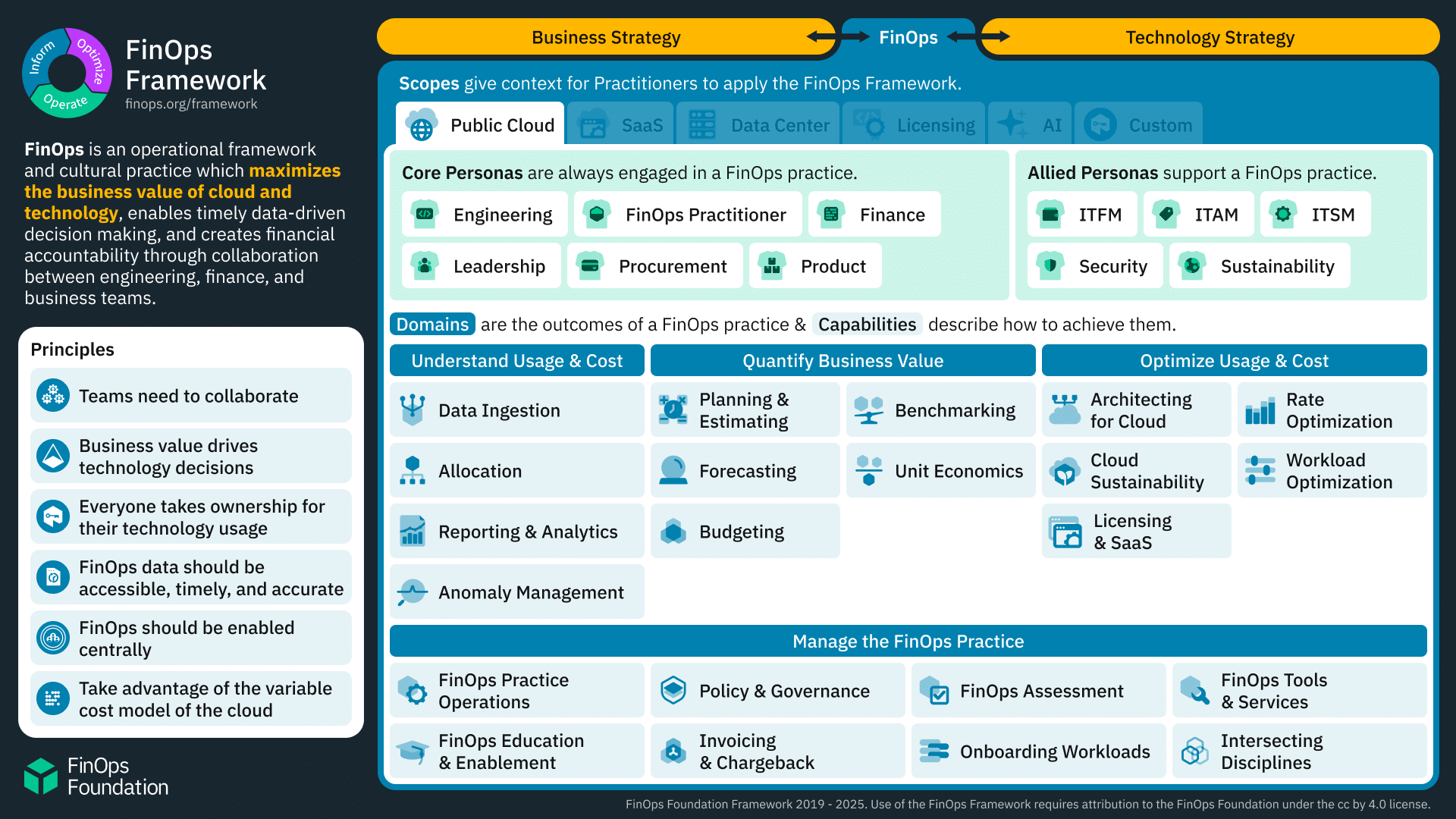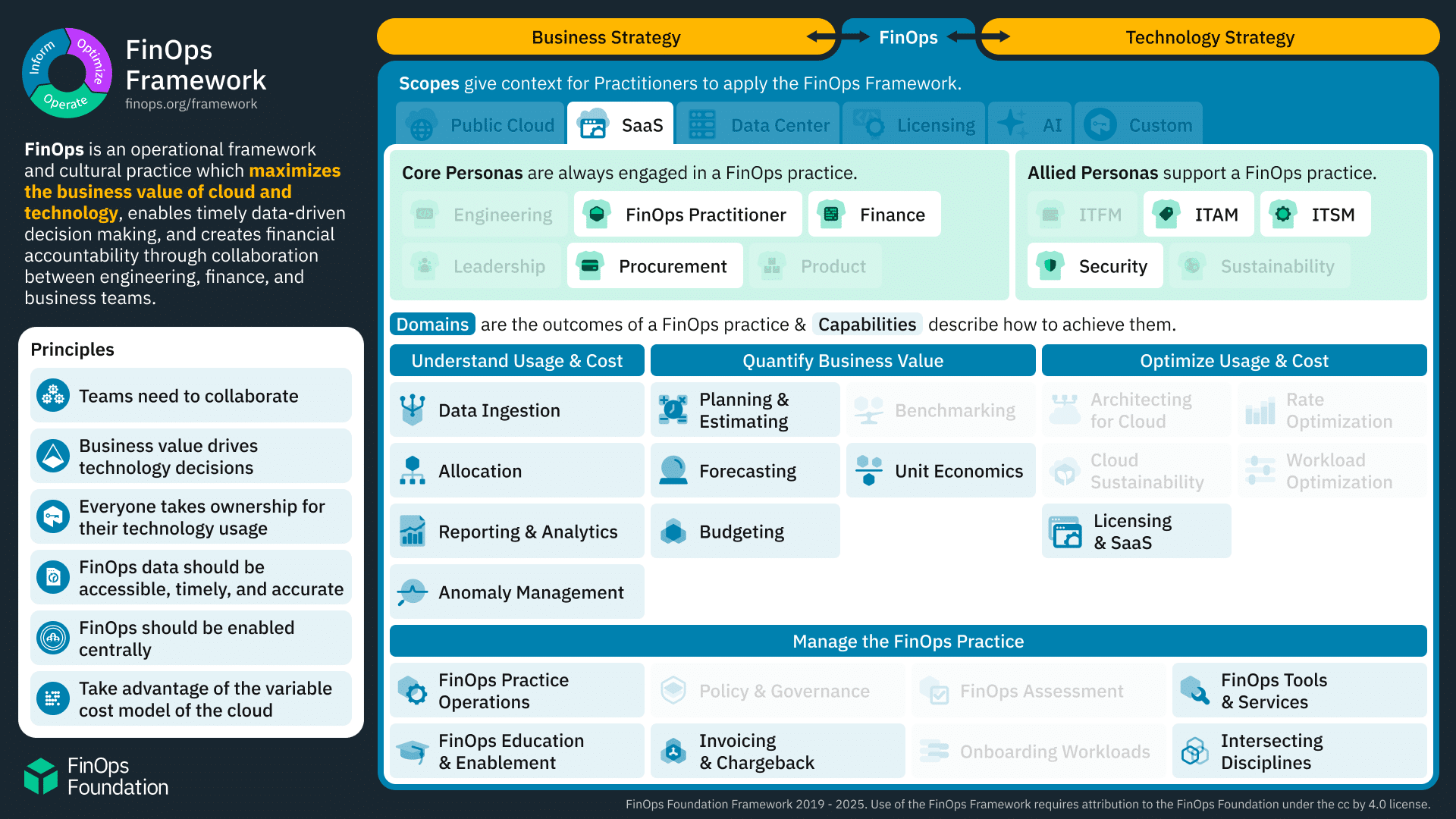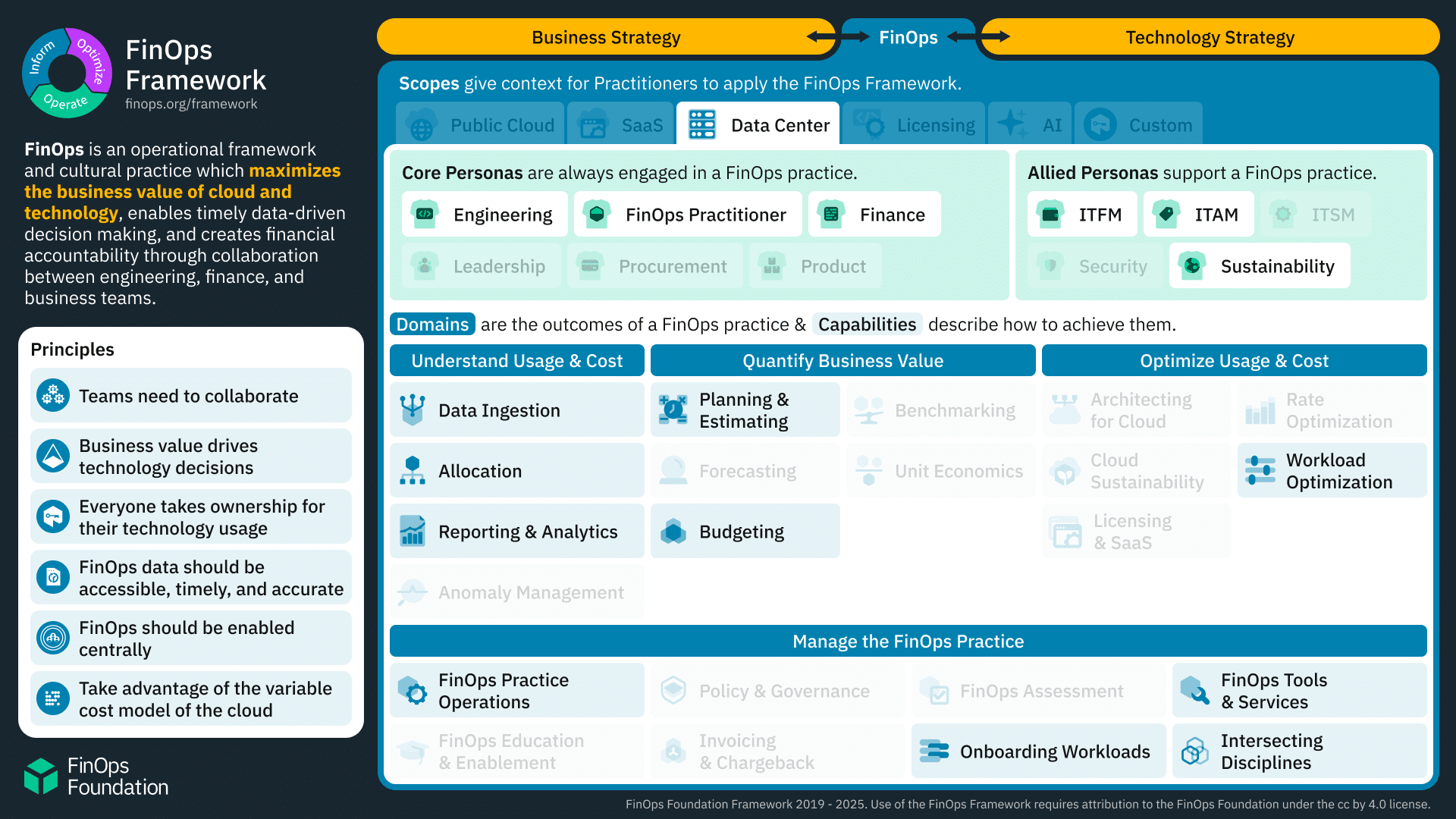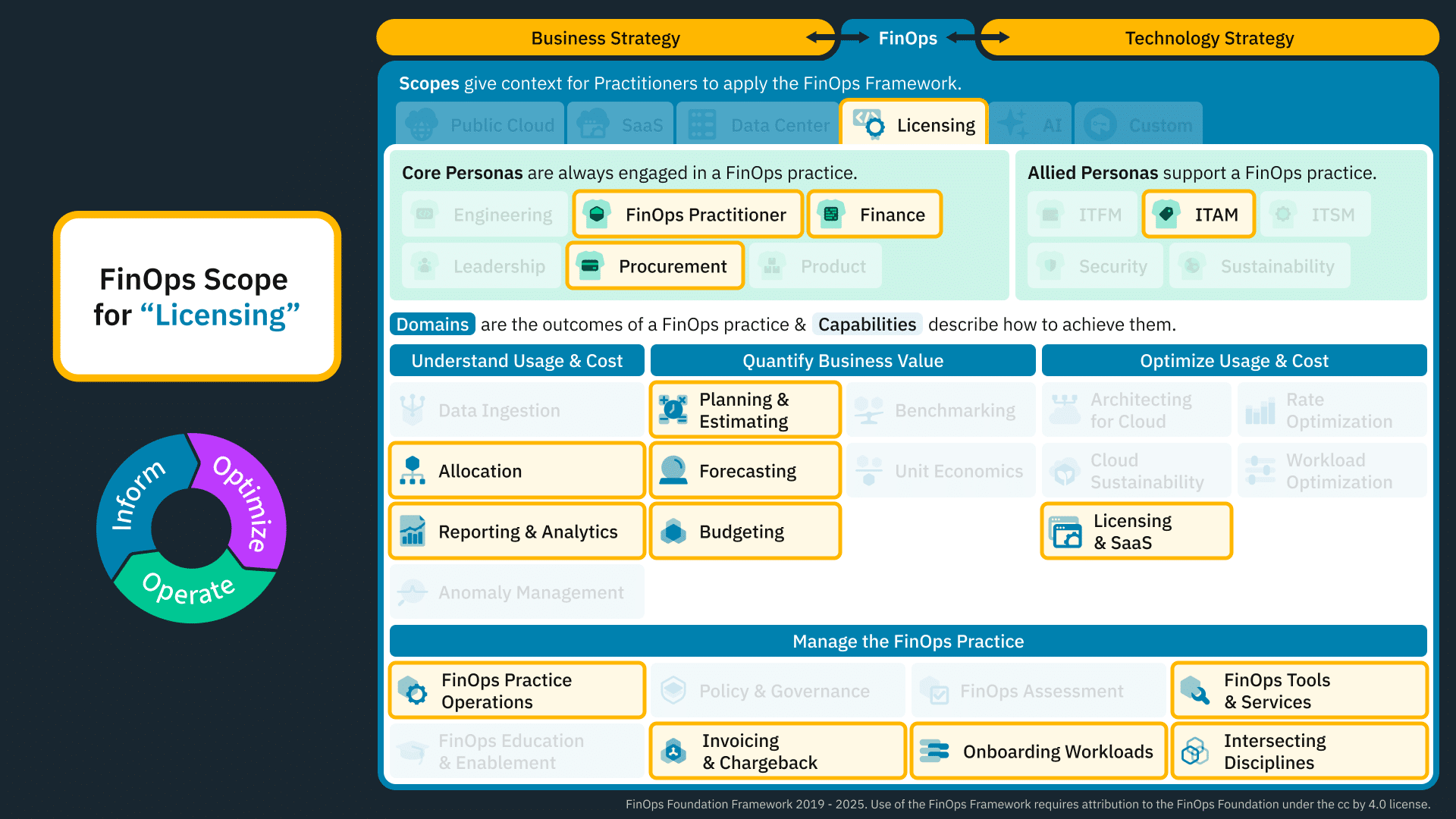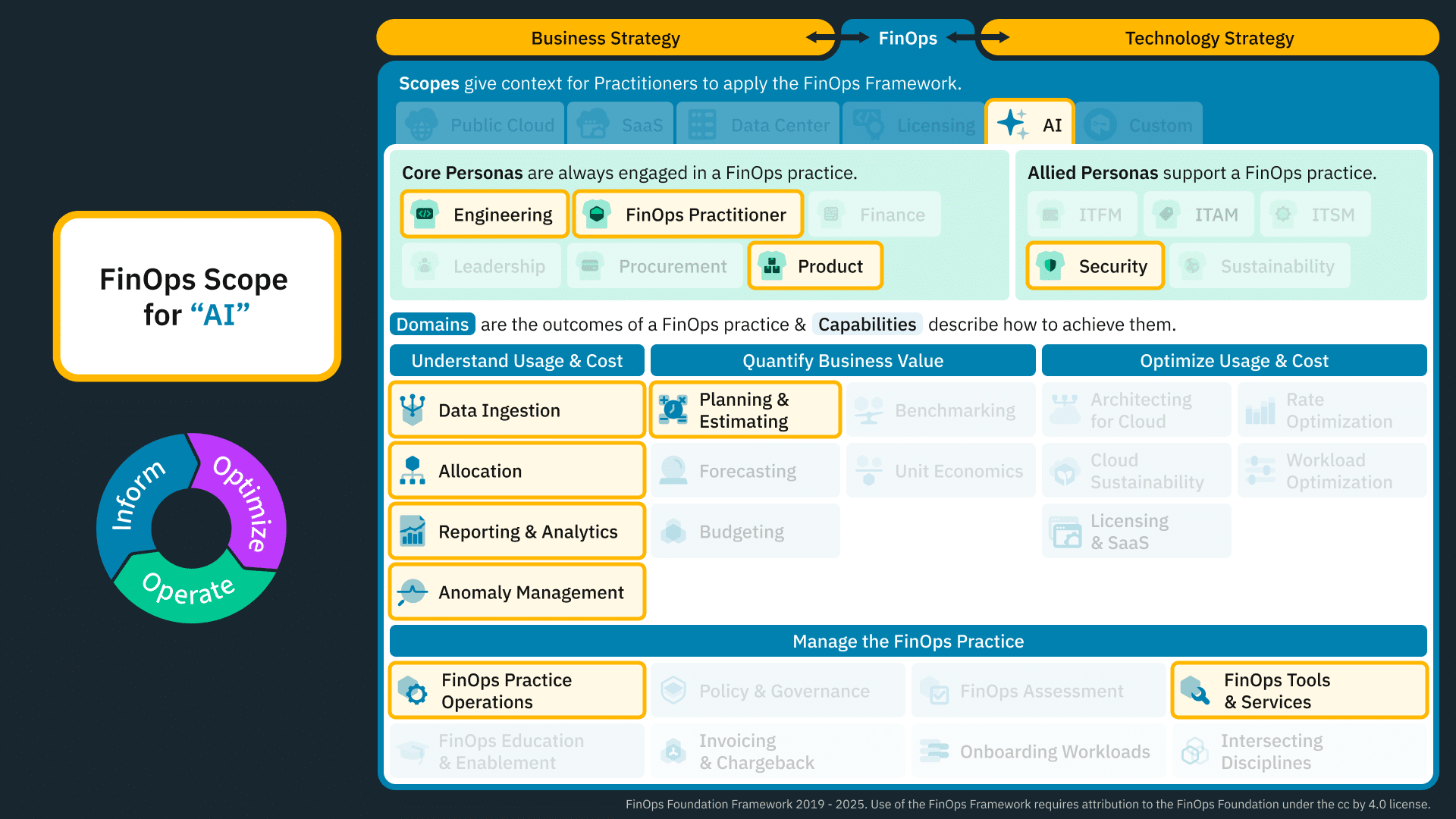FinOps Scopes
A FinOps Scope is a segment of technology-related spending to which FinOps Practitioners apply FinOps concepts.
Most FinOps practices started by managing public cloud. As FinOps practices expand to manage technology spending on SaaS, Data Center, Licenses, Labor, and other areas, it is important to distinguish how to apply FinOps concepts to create value within these other areas of IT.
An organization’s technology strategy and business strategy will inform how a FinOps Capability like Data Ingestion, Allocation, or Forecasting is applied to – for example – a segment of Data Center spending. Some FinOps activities may have very different inputs, KPIs, or measures of success for these other segments of spending than when used by a FinOps team for public cloud.
For any area of IT investment, even including public cloud, a FinOps practice may only need to focus on a specific segment of usage – like a hybrid Kubernetes deployment across public cloud and on-premises in an organization’s data center – resulting in the creation of a FinOps Scope within the FinOps practice just for this segment of spending.
FinOps Scopes enables practitioners to construct the context needed to frame conversations and expectations about which people (Personas), activities (Capabilities), and outcomes (Domains) are in scope for the FinOps practice. We can visualize creating a FinOps Scope by navigating the Framework poster from the top-down.
A FinOps practice will ultimately define multiple FinOps Scopes as part of the practice profile. Each Scope may have different people, processes, and technologies involved. The inclusion or exclusion of FinOps Framework elements when constructing a FinOps Scope should reflect your organization’s technology strategy, business strategy, and FinOps Maturity.
Scopes are driven by the business & technology strategy
- Organizations can determine their own custom FinOps Scope(s) based on the mix of technologies and spend that is important to their business
- Framework Capabilities can be prioritized or excluded by Scope based on business objectives
- FinOps Personas can be engaged or excluded as appropriate for each FinOps Scope
Scopes are more than a single type of infrastructure
- A Scope may operate across multiple types of infrastructure (e.g. AI or Licensing)
- There may be multiple Scopes within a single type of spend (e.g. Public Cloud)
- Unique KPIs and thresholds for metrics may be associated with a Capability in a Scope, even if that Capability is included in other Scopes
Scopes determine which Personas, Domains, and Capabilities are Engaged
Elements of the FinOps Framework – such as Personas, Domains, and Capabilities – act as foundational building blocks for your FinOps Scopes. Selection or exclusion of these elements should reflect your organization’s FinOps Maturity, business priorities, and situational context. Practitioners can then apply these Scopes to structure their FinOps activities, define ownership boundaries, and align teams around measurable outcomes. As your practice evolves, the Framework elements included or excluded will change. Scopes provide a construct to build the context to focus improvement efforts and benchmark maturity across different areas of FinOps.
Only create a new scope when you need to
- Just as you should strive to only mature your FinOps practice when doing so creates value, only consider new scopes when critical
- There is an overhead to establishing and tracking many Scopes of practice, so keep it simple when possible
- Many of the Capabilities, Personas and Domains can be practiced in the same manner, with only a few exceptions
FinOps Scopes for Public Cloud
Public Cloud remains the foundational FinOps Scope, since the practice of FinOps emerged to address the cost management challenges of cloud.
FinOps Scopes Beyond Public Cloud
Feedback from the FinOps community, FinOps Foundation Working Groups, and conversations with the TAC identified that FinOps teams are managing additional scopes of technology spend. FinOps Scopes for Software-as-a-Service (SaaS) and for Data Center are the first to be listed in the FinOps Framework alongside Public Cloud.
Software-as-a-Service (SaaS)
A sample Framework poster highlighting which Personas, Domains, and Capabilities may be involved in the FinOps for SaaS Scope as driven by business and technology priorities.
Elements of the FinOps Framework highlighted for the FinOps for SaaS Scope – such as Personas, Domains, and Capabilities – act as foundational building blocks for your FinOps Scopes. Greyed areas remain part of the Framework and represent building blocks that could also included. The inclusion or exclusion of FinOps Framework elements adopted for your FinOps practice should reflect your organization’s FinOps Maturity and situational context.
Data Center
A sample Framework poster highlighting which Personas, Domains, and Capabilities may be involved in the FinOps for Data Center Scope as driven by business and technology priorities.
Elements of the FinOps Framework highlighted for the FinOps for Data Center Scope – such as Personas, Domains, and Capabilities – act as foundational building blocks for your FinOps Scopes. Greyed areas remain part of the Framework and represent building blocks that could also included. The inclusion or exclusion of FinOps Framework elements adopted for your FinOps practice should reflect your organization’s FinOps Maturity and situational context.
Custom Scopes
Applying elements of the FinOps Framework to create a FinOps for Licensing Scope or FinOps for AI Scope are driven by business and technology priorities.
The highlighted Personas, Domains, and Capabilities act as foundational building blocks. Greyed areas remain part of the Framework and represent building blocks that could also included. The inclusion or exclusion of FinOps Framework elements adopted for your FinOps practice should reflect your organization’s FinOps Maturity and situational context.
